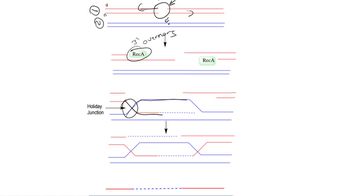A mixed infection of two bacteriophage strains is often used for what purpose?
Table of contents
- 1. Introduction to Genetics51m
- 2. Mendel's Laws of Inheritance3h 37m
- 3. Extensions to Mendelian Inheritance2h 41m
- 4. Genetic Mapping and Linkage2h 28m
- 5. Genetics of Bacteria and Viruses1h 21m
- 6. Chromosomal Variation1h 48m
- 7. DNA and Chromosome Structure56m
- 8. DNA Replication1h 10m
- 9. Mitosis and Meiosis1h 34m
- 10. Transcription1h 0m
- 11. Translation58m
- 12. Gene Regulation in Prokaryotes1h 19m
- 13. Gene Regulation in Eukaryotes44m
- 14. Genetic Control of Development44m
- 15. Genomes and Genomics1h 50m
- 16. Transposable Elements47m
- 17. Mutation, Repair, and Recombination1h 6m
- 18. Molecular Genetic Tools19m
- 19. Cancer Genetics29m
- 20. Quantitative Genetics1h 26m
- 21. Population Genetics50m
- 22. Evolutionary Genetics29m
5. Genetics of Bacteria and Viruses
Bacteriophage Genetics
Problem 2
Textbook Question
Write a short summary that contrasts how recombination occurs in bacteria and bacteriophages.
 Verified step by step guidance
Verified step by step guidance1
Step 1: Define recombination in the context of genetics as the process by which genetic material is rearranged to produce new combinations of genes, increasing genetic diversity.
Step 2: Explain that in bacteria, recombination typically occurs through processes such as transformation (uptake of free DNA), transduction (DNA transfer via bacteriophages), and conjugation (direct transfer between bacteria), often involving homologous recombination where similar DNA sequences are exchanged.
Step 3: Describe that in bacteriophages, recombination mainly occurs during the infection cycle, especially through mechanisms like site-specific recombination or homologous recombination when multiple phage genomes are present in the same host, allowing exchange of genetic material between phage genomes.
Step 4: Contrast the two by noting that bacterial recombination often involves integration of foreign DNA into the bacterial chromosome to create genetic variation in the bacterial population, while phage recombination primarily reshuffles phage genetic material to generate new phage variants.
Step 5: Summarize that bacterial recombination is a key driver of bacterial evolution and adaptation, whereas phage recombination contributes to phage diversity and can influence phage-host interactions.
 Verified video answer for a similar problem:
Verified video answer for a similar problem:This video solution was recommended by our tutors as helpful for the problem above
Video duration:
2mPlay a video:
Was this helpful?
Key Concepts
Here are the essential concepts you must grasp in order to answer the question correctly.
Bacterial Recombination Mechanisms
In bacteria, recombination primarily occurs through processes like transformation, transduction, and conjugation, which involve the exchange or uptake of DNA between cells. These mechanisms allow bacteria to acquire genetic diversity without sexual reproduction, often involving homologous recombination to integrate new DNA into the genome.
Recommended video:
Guided course

Recombination after Single Strand Breaks
Phage Recombination Processes
Bacteriophages undergo recombination mainly during their replication cycles, especially through genetic exchanges between phage genomes during co-infection of a host. This can involve homologous recombination or site-specific recombination, enabling phages to generate genetic diversity and adapt to host defenses.
Recommended video:
Guided course

mRNA Processing
Differences in Recombination Context and Purpose
While bacterial recombination often serves to increase genetic variation and adaptability in a population, phage recombination is closely tied to their replication and survival within host cells. Bacterial recombination involves DNA transfer between cells, whereas phage recombination occurs within the viral genomes during infection.
Recommended video:
Guided course

Recombination after Double Strand Breaks

 3:44m
3:44mWatch next
Master Plaques and Experiments with a bite sized video explanation from Kylia
Start learningRelated Videos
Related Practice
Multiple Choice
477
views
